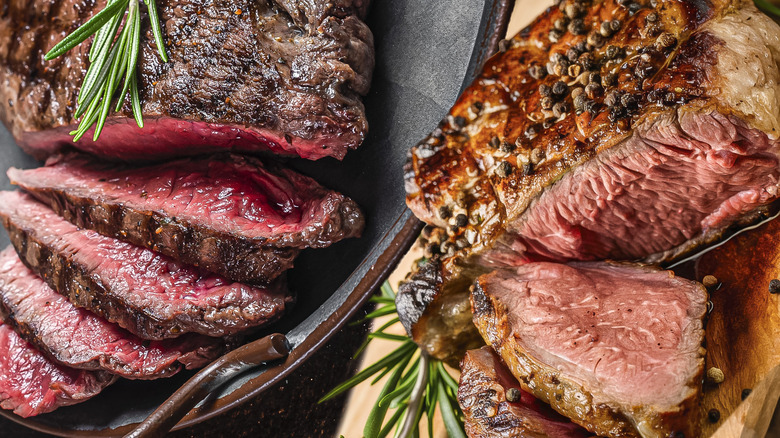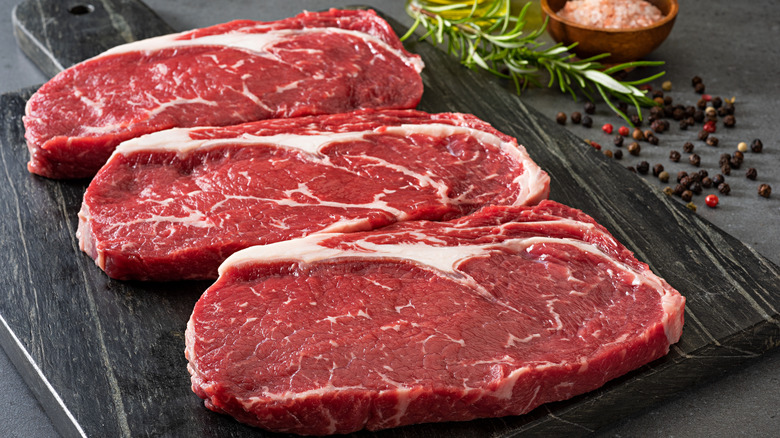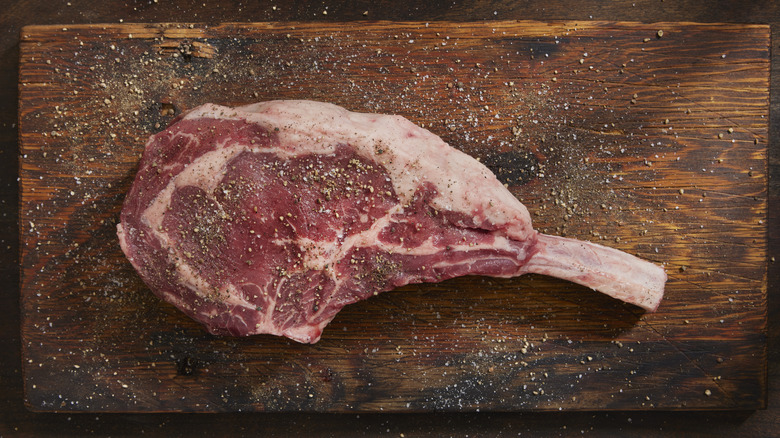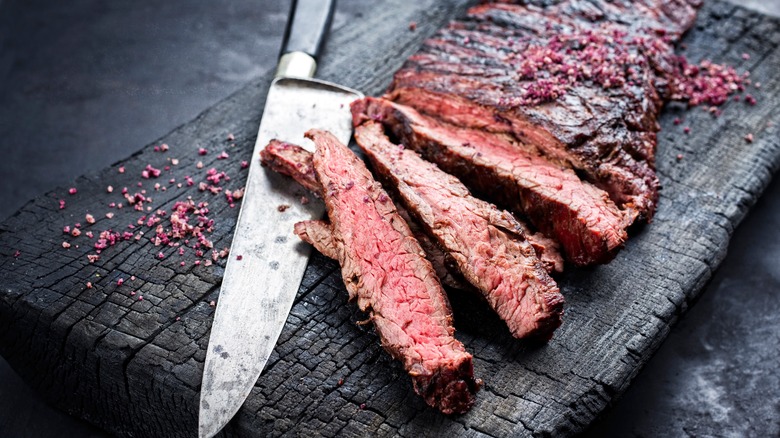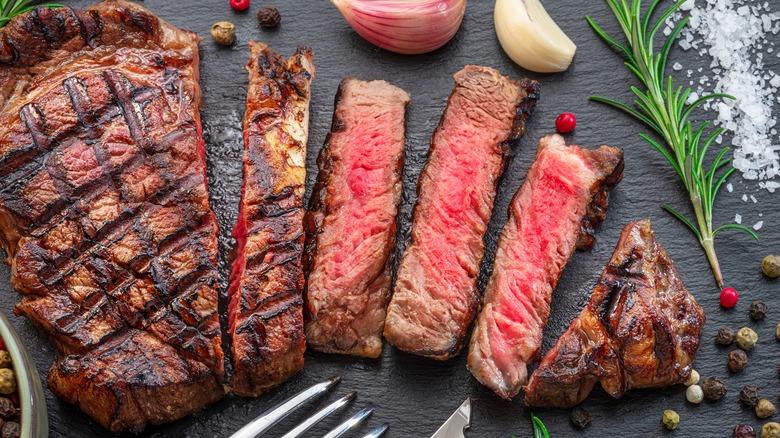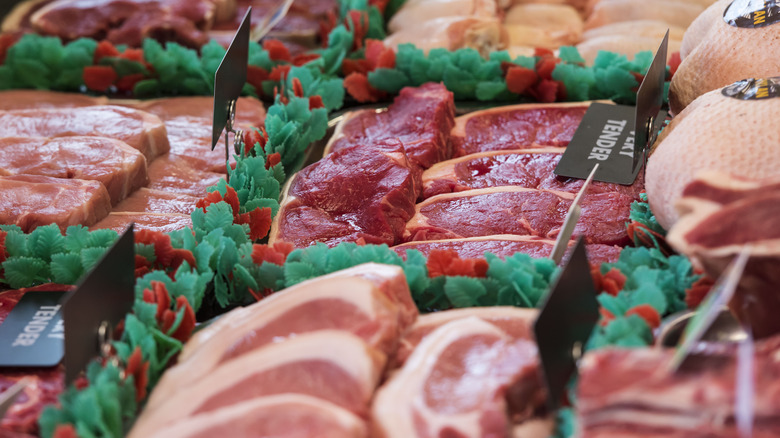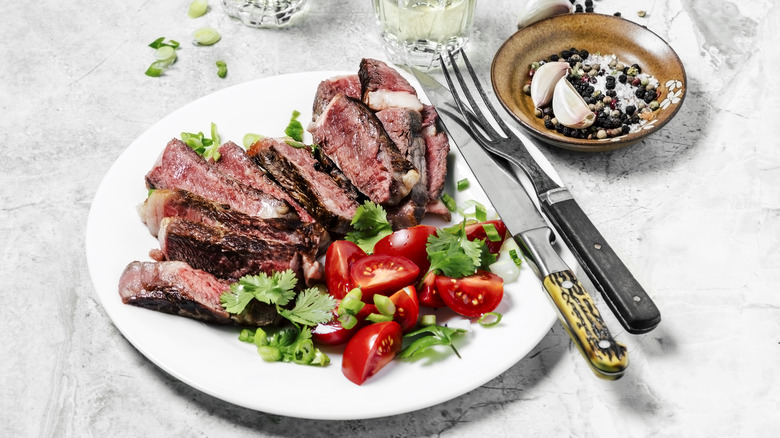Explaining The Difference Between Sirloin Steak And The Coveted Ribeye
You might be looking at a sirloin and ribeye steak on a menu and know somehow that you are supposed to want the ribeye, but do you actually know the differences that make people say that? There are a lot of cuts of steak out there, and it's easy to get confused. You can fall into the trap of "steak good," and just assume that most cuts of steaks are the same, which isn't true.
Or you could make the opposite mistake and think that only desirable cuts like porterhouse or ribeye are worth ordering. Yet like so many things in life, the truth lies somewhere in between. There are some pretty good reasons ribeye is valued over sirloin cuts, but every steak can be made delicious if you know the differences well enough to cook them right.
When people start ranking steak cuts, ribeye is usually at or near the top , and while sirloin isn't disrespected, it usually isn't loved either. The reality is that it all comes down to personal taste. Filet mignon is one of the most expensive, coveted steaks out there, yet plenty of steak lovers would choose a cheap, flavorful skirt steak over the lean filet every time. Sirloin may not be as juicy as a ribeye, but it has plenty to recommend it, and lots of recipes where it might even be preferred. Ribeye and sirloin have different textures, marbling, and tastes but, in the end, they are both steak.
What is a sirloin steak?
One complication you'll run into right off the bat with sirloin is that there are a lot of different sirloin steaks. The sirloin is what is known as a primal cut of beef, one of the larger sections of the cow that then gets cut into smaller, more specific steaks. The sirloin primal is located near the back of the cow, between the ribs and the round, or rump. The sirloin is separated from the short loin next to it, and the two are connected by the tenderloin, which is what gets divided up into filet mignon or porterhouse steaks. The large sirloin is further split into two subsections before becoming steaks, called subprimals, which are the top sirloin and bottom sirloin.
If you get a steak that is just called a sirloin steak, it is usually from the top sirloin, as the bottom is made into larger, tougher cuts that are better for roasting, like tri-tip. Top sirloin steaks come in a few different styles like top sirloin filet and center cut top sirloin. Because they sit in a section of the cow that gets lots of work, sirloin cuts are less tender and leaner than more expensive steaks. However, they can still be relatively balanced, as they are not overly tough and have a strong beef flavor.
What is ribeye steak?
Ribeye is a specific cut of steak from the larger rib primal cut, which is the section of the cow between the loin and shoulders, also known as the chuck. Ribeye steaks come from the same section of the primal, the rib roast, which is used to make prime rib. Essentially, ribeye steaks are cut from the rib roast as individual steaks before they are cooked, as opposed to cooking the roast whole.
They can be cut bone-in or cut boneless from the space between the rib bones. Ribeye may also go by the name Delmonico steak when sold boneless, or be called a cowboy steak when sold frenched. The ribeye is also relatively large for a single steak cut, making for a very generous meal.
Ribeye is special for a lot of reasons, but it's most famous for its excellent fat marbling. The area around the rib of the cow gathers lots of fat and, in the ribeye, it is perfectly flecked and streaked through the steak. However, it does have a little more connective tissue than other desirable cuts of steak, so it helps to cook ribeye to a slightly higher temperature to break down the tissue and make it as tender as possible. Ribeyes are a versatile cut that is hard to overcook, and it's considered a favorite among people who like fattier cuts of steak.
Sirloin encompasses many unique cuts of steak
Even on the shelf, sirloin and ribeye are going to present you with big differences because of how they are classified and labeled. As noted before, the sirloin is a large cut with lots of different steaks to choose from, and while they share some key characteristics, they aren't identical. While the bottom sirloin makes good roasts, there are also cuts like the bavette steak, which is a flavorful but tough cut similar to flank steak. The top sirloin is on the lean side but still has enough fat to be juicy and make good seared or grilled steaks. One lesser known sirloin steak is called the coulotte steak. Cut from the sirloin cap, coulette is an even better marbled form of sirloin steak.
While ribeye is much more specific than sirloin, referring to that one small area of the rib, there are a few different styles of ribeye beyond bone-in or boneless. The somewhat redundantly named eye of ribeye comes from the center of the cut and has the most meat. Then there is the ribeye cap, which may be the most coveted part of the ribeye. Separated from the eye by a layer of fat, the ribeye cap is even more tender than the rest of the cut while maintaining its signature marbling. Any form of ribeye is going to satisfy a steak-lover, but the ribeye cap is something special.
Ribeye is more tender and flavorful
When looking for what makes a steak great, people are looking for flavor, juiciness, and tenderness, and ribeye checks all three boxes in a balance no other cut of steak can really touch. The area around the rib of the cow gets very little work, which means the meat is naturally tender without the need for any marinade. The lack of work the ribeye gets also contributes to the high amount of fat on the steak, which is the key to ribeye's exceptional flavor and to keeping it moist. And what is nice about a ribeye's fat is that its well distributed throughout the meat, helping it melt evenly instead of becoming big rubbery hunks. In fact a ribeye has such a rich buttery flavor that it doesn't need any additional spices or ingredients when cooked beyond the basics of some salt and maybe black pepper.
Sirloin is less fatty and tender than ribeye, but it can still be a flavorful steak, and some people may even prefer the more lean, beefy taste to the richer ribeye. It still has a small level of fat marbling to keep it juicy, and it's more mild flavor makes it great for a variety of uses. While tasty on it's own, sirloin is a cut of steak where you can reach for a dry rub seasoning mix or cut it up in a saucy stir-fry without steak lovers yelling at you for wasting it.
Sirloin steaks are more affordable
Sirloin is great for lots of things beyond being served straight up as a steak because it is also lighter on your wallet than ribeye. Leaner, tougher cuts tend to be the most affordable cuts of steak since they are in less demand. Sirloin also doesn't have the brand recognition factor of big name cuts like New York Strip, T-bone, or even flank steak, which helps keep the cost down. It's not as cheap as cuts used primarily for roasting like round or tri-tip, but for steak cuts, it is often a few dollars per pound cheaper than other, more in-demand steaks.
Ribeye is the opposite of sirloin here in almost every way. It has a reputation for producing some of the best steaks and is priced accordingly. Filet Mignon or tenderloin is usually the most expensive cut, but outside of that only porterhouse and flank steak are as highly priced. The one way you can save a few bucks on ribeye is by opting for bone-in cuts over boneless, which cuts some of the cost of preparation from the store, but either way, if you want all of the tender juiciness and flavor that ribeye has to offer, you're paying for it.
Ribeyes are better for quick cooking
Ribeye's already tender meat and well-marbled fat mean you don't want to spend too long cooking it, and the steak does best with simple preparations that let its natural flavor shine. This is best done over high heat in a cast iron skillet or hot grill, although on a grill, you'll need to be careful about the melting fat dripping onto the flames. As a meal, you'll want to serve ribeye as a basic steak to enjoy its rich taste without distraction, ideally with some simple sides like roasted potatoes or a light salad. If you do want to serve it with sauces or as part of a dish, keep the pairings brighter to balance out the meat, like chimichurri or serving sliced ribeye as part of a steak salad.
Sirloin will make a great steak, but you can get a little bit more creative. Sirloin also does well over high heat on the grill or stovetop, but you'll need to be more precise with the timing and temperature to make sure it doesn't dry out. You should also utilize tips for juicy sirloin steaks, like marinating to squeeze in more flavor. As an affordable cut, sliced strips of sirloin are nice for things like fajitas and stir-fry dishes, or for quick breakfasts like steak and eggs. With their solid balance between taste and price, sirloin steaks may just be the most versatile steak in your cooking arsenal.
